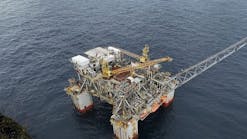WoodMac: US unconventional plays will help reduce imports from abroad
Unconventional oil and gas plays will continue to drive US and Canadian production for years, with the Bakken formation in North Dakota and Montana along with the South Texas Eagle Ford shale play accounting for much of the tight oil production increase, said analysts with Wood Mackenzie Ltd.
The Bakken and Eagle Ford are expected to account for more than half of WoodMac’s anticipated North America tight oil production volumes of more than 5 million b/d by 2019, analysts said during a recent webcast.
They estimate average 2013 production from the Eagle Ford will be 844,000 b/d, about 50% greater than the 2012 average. Analysts said the Karnes Trough condensate window is attracting the highest investment and development activity within the Eagle Ford play.
WoodMac estimates $150 billion will be spent this year on developing onshore US and Canadian oil and gas, and tight oil plays are expected to account for more than 40% of that. Anticipated growth in US crude oil production is estimated to cut waterborne imports of crude to 15% of the US oil supply by 2020 compared with about 44% now.
In the Permian basin, the Wolfcamp/Cline formations currently account for 7% of Permian basin production, but Wolfcamp/Cline oil production is expected to double its share of Permian production in 2018, WoodMac analysts said.
They estimate Wolfcamp/Cline oil production will average 195,000 b/d in 2018 compared with 111,000 b/d in 2013. The Ozona and Glasscock Nose subplays, both in the Midland basin, account for the vast majority of current production.
“Canada’s growth is less dependent on tight oil plays and more reliant on oil sands projects where project delays are possible,” WoodMac said. “For the near term, the country remains dependent on the US as an export market for its crude and therefore will continue to be adversely impacted by infrastructure constraints and pricing volatility south of the border.”
Regarding natural gas, WoodMac believes most gas development appears economic while costs continue to fall.
“Nearly all current US gas drilling is economic at prices above $4/MMbtu,” analysts said. “Supported by Marcellus and Utica development, Northeast production nearly doubles by 2020 from current levels.” They forecast Marcellus gas production will average over 14 bcfd in 2020 compared with a projected 2014 average of over 10 bcfd in 2014. For the Utica, analysts expect production will average 3 bcfd in 2020, up from more than 1 bcfd average in 2014.
Contact Paula Dittrick at [email protected].

Paula Dittrick | Senior Staff Writer
Paula Dittrick has covered oil and gas from Houston for more than 20 years. Starting in May 2007, she developed a health, safety, and environment beat for Oil & Gas Journal. Dittrick is familiar with the industry’s financial aspects. She also monitors issues associated with carbon sequestration and renewable energy.
Dittrick joined OGJ in February 2001. Previously, she worked for Dow Jones and United Press International. She began writing about oil and gas as UPI’s West Texas bureau chief during the 1980s. She earned a Bachelor’s of Science degree in journalism from the University of Nebraska in 1974.
